Environmental Health and Communicable Disease: Avian Influenza Virus and Its Impact
VerifiedAdded on 2023/06/07
|7
|2570
|216
AI Summary
This essay discusses the impact of avian influenza virus on environmental health and communicable disease. It covers the origin, subtypes, signs and symptoms, global disease rate, potential risk for Australia, and climate change impact of the virus.
Contribute Materials
Your contribution can guide someone’s learning journey. Share your
documents today.

Running Head: ENVIRONMENTAL HEALTH AND COMMUNICABLE DISEASE 0
Environmental Health and Communicable Disease
9/5/2018
Environmental Health and Communicable Disease
9/5/2018
Secure Best Marks with AI Grader
Need help grading? Try our AI Grader for instant feedback on your assignments.

ENVIRONMENTAL HEALTH AND COMMUNICABLE DISEASE 1
Introduction
The essay brings about the discussion on the topic, ‘environmental health and
communicable diseases, and the related aspects. Environmental health and communicable
disease, is one of the major concern in today’s scenario that impacts on the health of the
environment and the society. Environmental health is the branch of the public health which
includes the natural and built environmental aspects affecting the human health. Therefore,
with context to the essay, it can be stated that the communicable diseases are spread from one
person to other or from an animal to the person. There are a number of factors which
influence the spread of the communicable disease leading to the epidemics. Therefore, one of
the communicable disease or Flu is taken under research i.e. Avian Influenza, which is a bird
Flu and the related aspects and concepts determining the level of health and disease (Ding et
al, 2016).
Origin of the virus
Avian Influenza was recorded for the first time, in Italy 1878, and the disease at that
time was known as Fowl Plague. The continuous spread of this disease led to the situation of
outbreaks in poultry, consisting of two in the United States. It has been found that the virus
leading to Fowl Plague is an influenza virus. In the year 1997, highly pathogenic avian
influenza (HPAI), was discovered. H5N1 was found in the humans in Hong Kong which
received a great publicity (Yu et al, 2014).
The virus had been reported and held responsible for a number of confirmed bird flu
infections in the humans and their impact. It killed 60 people in the year 1997, when the virus
was first detected in humans. Avian influenza spreads sporadically throughout the world, and
the diseases had severe impact on the poultry industry, harming millions of chickens, and
geese. The virus is similar to the other viruses acting as illness caused due to the strains of
influenza virus, which adapts itself to a particular host. Amongst all three types of virus, i.e.
(A, B, and C), virus A refers to the zoonotic infection that contains a natural reservoir in
birds, and specifically Avian influenza is referred to the influenza ‘A’ virus (Chan et al.,
2015).
Introduction
The essay brings about the discussion on the topic, ‘environmental health and
communicable diseases, and the related aspects. Environmental health and communicable
disease, is one of the major concern in today’s scenario that impacts on the health of the
environment and the society. Environmental health is the branch of the public health which
includes the natural and built environmental aspects affecting the human health. Therefore,
with context to the essay, it can be stated that the communicable diseases are spread from one
person to other or from an animal to the person. There are a number of factors which
influence the spread of the communicable disease leading to the epidemics. Therefore, one of
the communicable disease or Flu is taken under research i.e. Avian Influenza, which is a bird
Flu and the related aspects and concepts determining the level of health and disease (Ding et
al, 2016).
Origin of the virus
Avian Influenza was recorded for the first time, in Italy 1878, and the disease at that
time was known as Fowl Plague. The continuous spread of this disease led to the situation of
outbreaks in poultry, consisting of two in the United States. It has been found that the virus
leading to Fowl Plague is an influenza virus. In the year 1997, highly pathogenic avian
influenza (HPAI), was discovered. H5N1 was found in the humans in Hong Kong which
received a great publicity (Yu et al, 2014).
The virus had been reported and held responsible for a number of confirmed bird flu
infections in the humans and their impact. It killed 60 people in the year 1997, when the virus
was first detected in humans. Avian influenza spreads sporadically throughout the world, and
the diseases had severe impact on the poultry industry, harming millions of chickens, and
geese. The virus is similar to the other viruses acting as illness caused due to the strains of
influenza virus, which adapts itself to a particular host. Amongst all three types of virus, i.e.
(A, B, and C), virus A refers to the zoonotic infection that contains a natural reservoir in
birds, and specifically Avian influenza is referred to the influenza ‘A’ virus (Chan et al.,
2015).
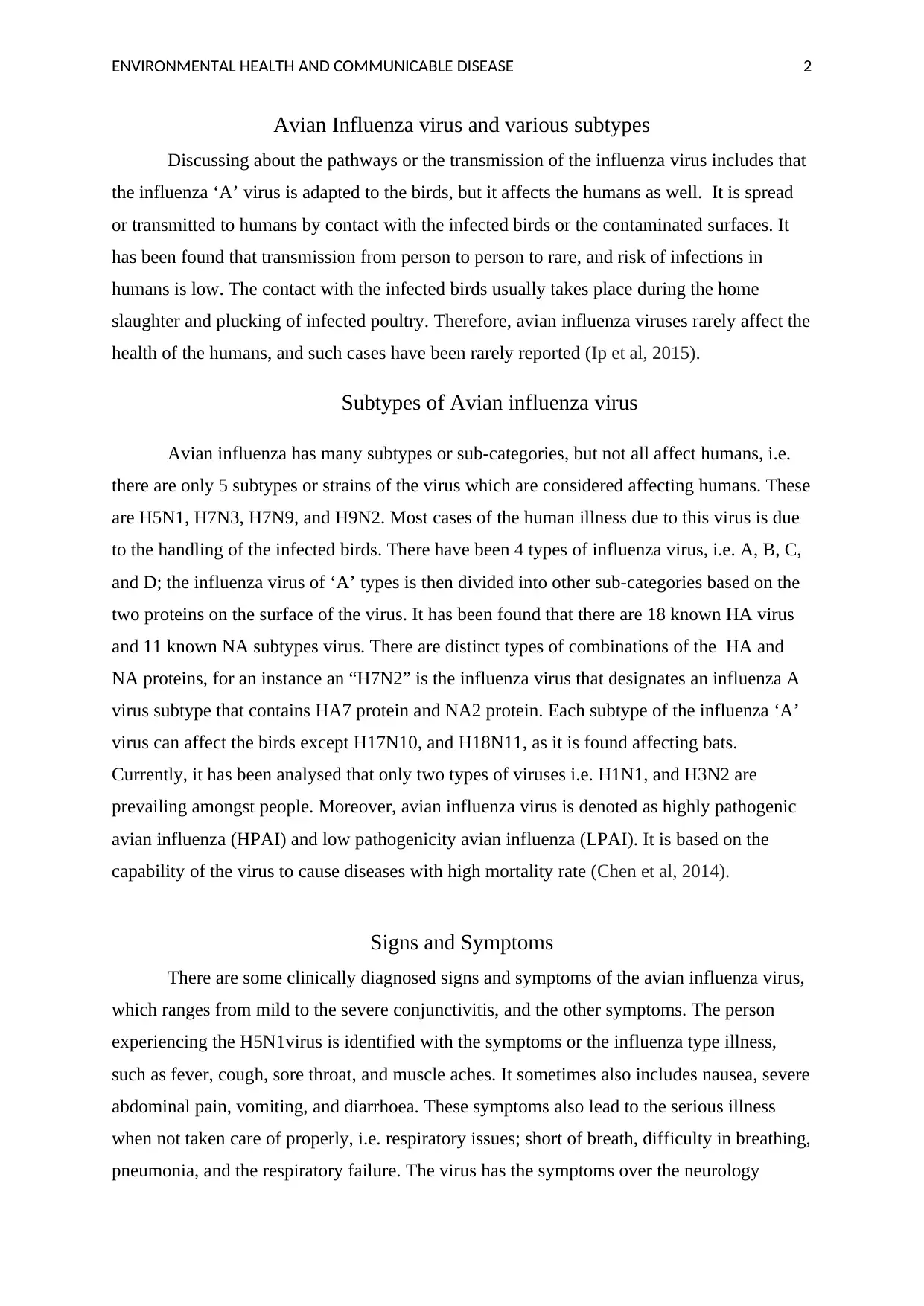
ENVIRONMENTAL HEALTH AND COMMUNICABLE DISEASE 2
Avian Influenza virus and various subtypes
Discussing about the pathways or the transmission of the influenza virus includes that
the influenza ‘A’ virus is adapted to the birds, but it affects the humans as well. It is spread
or transmitted to humans by contact with the infected birds or the contaminated surfaces. It
has been found that transmission from person to person to rare, and risk of infections in
humans is low. The contact with the infected birds usually takes place during the home
slaughter and plucking of infected poultry. Therefore, avian influenza viruses rarely affect the
health of the humans, and such cases have been rarely reported (Ip et al, 2015).
Subtypes of Avian influenza virus
Avian influenza has many subtypes or sub-categories, but not all affect humans, i.e.
there are only 5 subtypes or strains of the virus which are considered affecting humans. These
are H5N1, H7N3, H7N9, and H9N2. Most cases of the human illness due to this virus is due
to the handling of the infected birds. There have been 4 types of influenza virus, i.e. A, B, C,
and D; the influenza virus of ‘A’ types is then divided into other sub-categories based on the
two proteins on the surface of the virus. It has been found that there are 18 known HA virus
and 11 known NA subtypes virus. There are distinct types of combinations of the HA and
NA proteins, for an instance an “H7N2” is the influenza virus that designates an influenza A
virus subtype that contains HA7 protein and NA2 protein. Each subtype of the influenza ‘A’
virus can affect the birds except H17N10, and H18N11, as it is found affecting bats.
Currently, it has been analysed that only two types of viruses i.e. H1N1, and H3N2 are
prevailing amongst people. Moreover, avian influenza virus is denoted as highly pathogenic
avian influenza (HPAI) and low pathogenicity avian influenza (LPAI). It is based on the
capability of the virus to cause diseases with high mortality rate (Chen et al, 2014).
Signs and Symptoms
There are some clinically diagnosed signs and symptoms of the avian influenza virus,
which ranges from mild to the severe conjunctivitis, and the other symptoms. The person
experiencing the H5N1virus is identified with the symptoms or the influenza type illness,
such as fever, cough, sore throat, and muscle aches. It sometimes also includes nausea, severe
abdominal pain, vomiting, and diarrhoea. These symptoms also lead to the serious illness
when not taken care of properly, i.e. respiratory issues; short of breath, difficulty in breathing,
pneumonia, and the respiratory failure. The virus has the symptoms over the neurology
Avian Influenza virus and various subtypes
Discussing about the pathways or the transmission of the influenza virus includes that
the influenza ‘A’ virus is adapted to the birds, but it affects the humans as well. It is spread
or transmitted to humans by contact with the infected birds or the contaminated surfaces. It
has been found that transmission from person to person to rare, and risk of infections in
humans is low. The contact with the infected birds usually takes place during the home
slaughter and plucking of infected poultry. Therefore, avian influenza viruses rarely affect the
health of the humans, and such cases have been rarely reported (Ip et al, 2015).
Subtypes of Avian influenza virus
Avian influenza has many subtypes or sub-categories, but not all affect humans, i.e.
there are only 5 subtypes or strains of the virus which are considered affecting humans. These
are H5N1, H7N3, H7N9, and H9N2. Most cases of the human illness due to this virus is due
to the handling of the infected birds. There have been 4 types of influenza virus, i.e. A, B, C,
and D; the influenza virus of ‘A’ types is then divided into other sub-categories based on the
two proteins on the surface of the virus. It has been found that there are 18 known HA virus
and 11 known NA subtypes virus. There are distinct types of combinations of the HA and
NA proteins, for an instance an “H7N2” is the influenza virus that designates an influenza A
virus subtype that contains HA7 protein and NA2 protein. Each subtype of the influenza ‘A’
virus can affect the birds except H17N10, and H18N11, as it is found affecting bats.
Currently, it has been analysed that only two types of viruses i.e. H1N1, and H3N2 are
prevailing amongst people. Moreover, avian influenza virus is denoted as highly pathogenic
avian influenza (HPAI) and low pathogenicity avian influenza (LPAI). It is based on the
capability of the virus to cause diseases with high mortality rate (Chen et al, 2014).
Signs and Symptoms
There are some clinically diagnosed signs and symptoms of the avian influenza virus,
which ranges from mild to the severe conjunctivitis, and the other symptoms. The person
experiencing the H5N1virus is identified with the symptoms or the influenza type illness,
such as fever, cough, sore throat, and muscle aches. It sometimes also includes nausea, severe
abdominal pain, vomiting, and diarrhoea. These symptoms also lead to the serious illness
when not taken care of properly, i.e. respiratory issues; short of breath, difficulty in breathing,
pneumonia, and the respiratory failure. The virus has the symptoms over the neurology
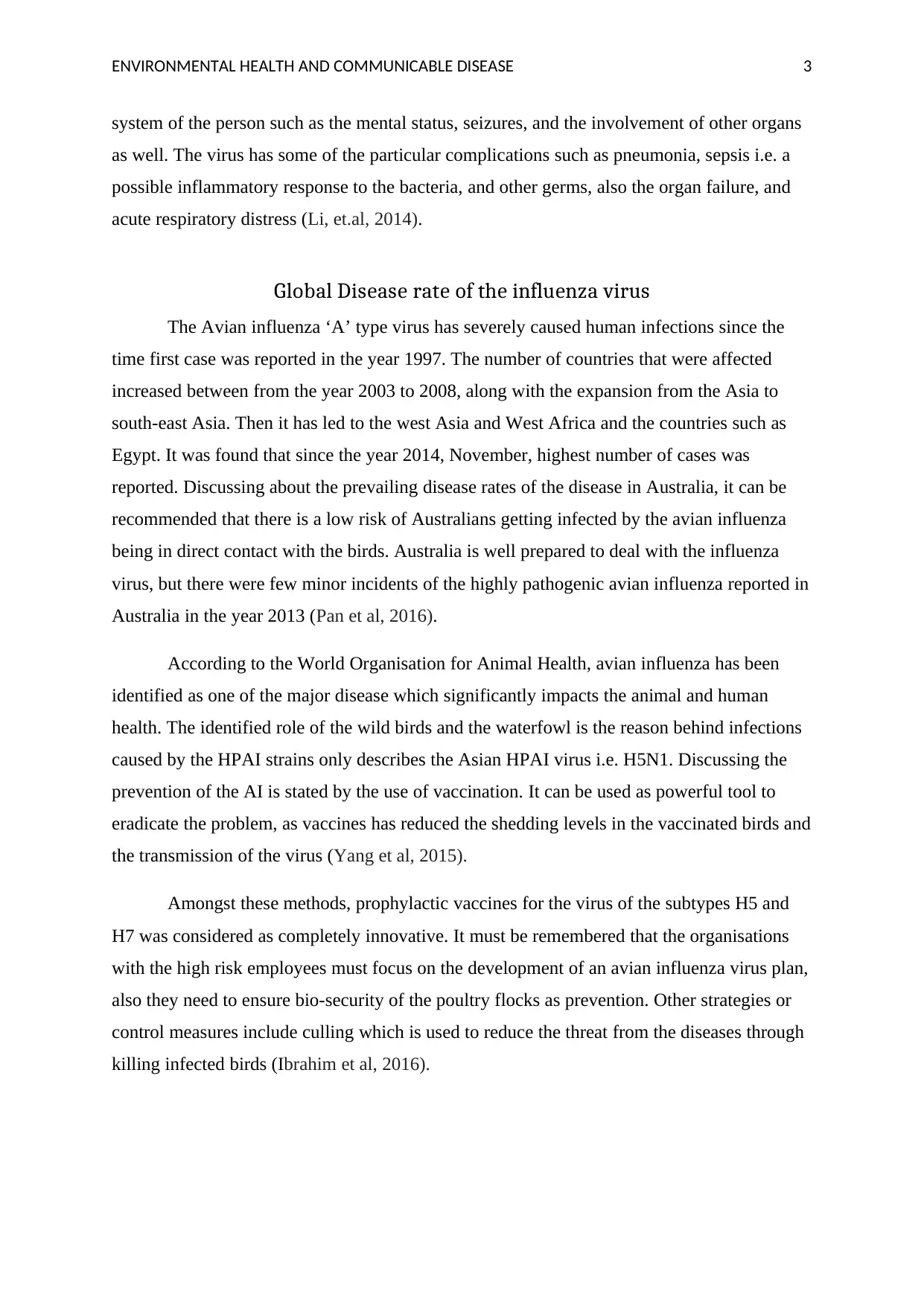
ENVIRONMENTAL HEALTH AND COMMUNICABLE DISEASE 3
system of the person such as the mental status, seizures, and the involvement of other organs
as well. The virus has some of the particular complications such as pneumonia, sepsis i.e. a
possible inflammatory response to the bacteria, and other germs, also the organ failure, and
acute respiratory distress (Li, et.al, 2014).
Global Disease rate of the influenza virus
The Avian influenza ‘A’ type virus has severely caused human infections since the
time first case was reported in the year 1997. The number of countries that were affected
increased between from the year 2003 to 2008, along with the expansion from the Asia to
south-east Asia. Then it has led to the west Asia and West Africa and the countries such as
Egypt. It was found that since the year 2014, November, highest number of cases was
reported. Discussing about the prevailing disease rates of the disease in Australia, it can be
recommended that there is a low risk of Australians getting infected by the avian influenza
being in direct contact with the birds. Australia is well prepared to deal with the influenza
virus, but there were few minor incidents of the highly pathogenic avian influenza reported in
Australia in the year 2013 (Pan et al, 2016).
According to the World Organisation for Animal Health, avian influenza has been
identified as one of the major disease which significantly impacts the animal and human
health. The identified role of the wild birds and the waterfowl is the reason behind infections
caused by the HPAI strains only describes the Asian HPAI virus i.e. H5N1. Discussing the
prevention of the AI is stated by the use of vaccination. It can be used as powerful tool to
eradicate the problem, as vaccines has reduced the shedding levels in the vaccinated birds and
the transmission of the virus (Yang et al, 2015).
Amongst these methods, prophylactic vaccines for the virus of the subtypes H5 and
H7 was considered as completely innovative. It must be remembered that the organisations
with the high risk employees must focus on the development of an avian influenza virus plan,
also they need to ensure bio-security of the poultry flocks as prevention. Other strategies or
control measures include culling which is used to reduce the threat from the diseases through
killing infected birds (Ibrahim et al, 2016).
system of the person such as the mental status, seizures, and the involvement of other organs
as well. The virus has some of the particular complications such as pneumonia, sepsis i.e. a
possible inflammatory response to the bacteria, and other germs, also the organ failure, and
acute respiratory distress (Li, et.al, 2014).
Global Disease rate of the influenza virus
The Avian influenza ‘A’ type virus has severely caused human infections since the
time first case was reported in the year 1997. The number of countries that were affected
increased between from the year 2003 to 2008, along with the expansion from the Asia to
south-east Asia. Then it has led to the west Asia and West Africa and the countries such as
Egypt. It was found that since the year 2014, November, highest number of cases was
reported. Discussing about the prevailing disease rates of the disease in Australia, it can be
recommended that there is a low risk of Australians getting infected by the avian influenza
being in direct contact with the birds. Australia is well prepared to deal with the influenza
virus, but there were few minor incidents of the highly pathogenic avian influenza reported in
Australia in the year 2013 (Pan et al, 2016).
According to the World Organisation for Animal Health, avian influenza has been
identified as one of the major disease which significantly impacts the animal and human
health. The identified role of the wild birds and the waterfowl is the reason behind infections
caused by the HPAI strains only describes the Asian HPAI virus i.e. H5N1. Discussing the
prevention of the AI is stated by the use of vaccination. It can be used as powerful tool to
eradicate the problem, as vaccines has reduced the shedding levels in the vaccinated birds and
the transmission of the virus (Yang et al, 2015).
Amongst these methods, prophylactic vaccines for the virus of the subtypes H5 and
H7 was considered as completely innovative. It must be remembered that the organisations
with the high risk employees must focus on the development of an avian influenza virus plan,
also they need to ensure bio-security of the poultry flocks as prevention. Other strategies or
control measures include culling which is used to reduce the threat from the diseases through
killing infected birds (Ibrahim et al, 2016).
Secure Best Marks with AI Grader
Need help grading? Try our AI Grader for instant feedback on your assignments.
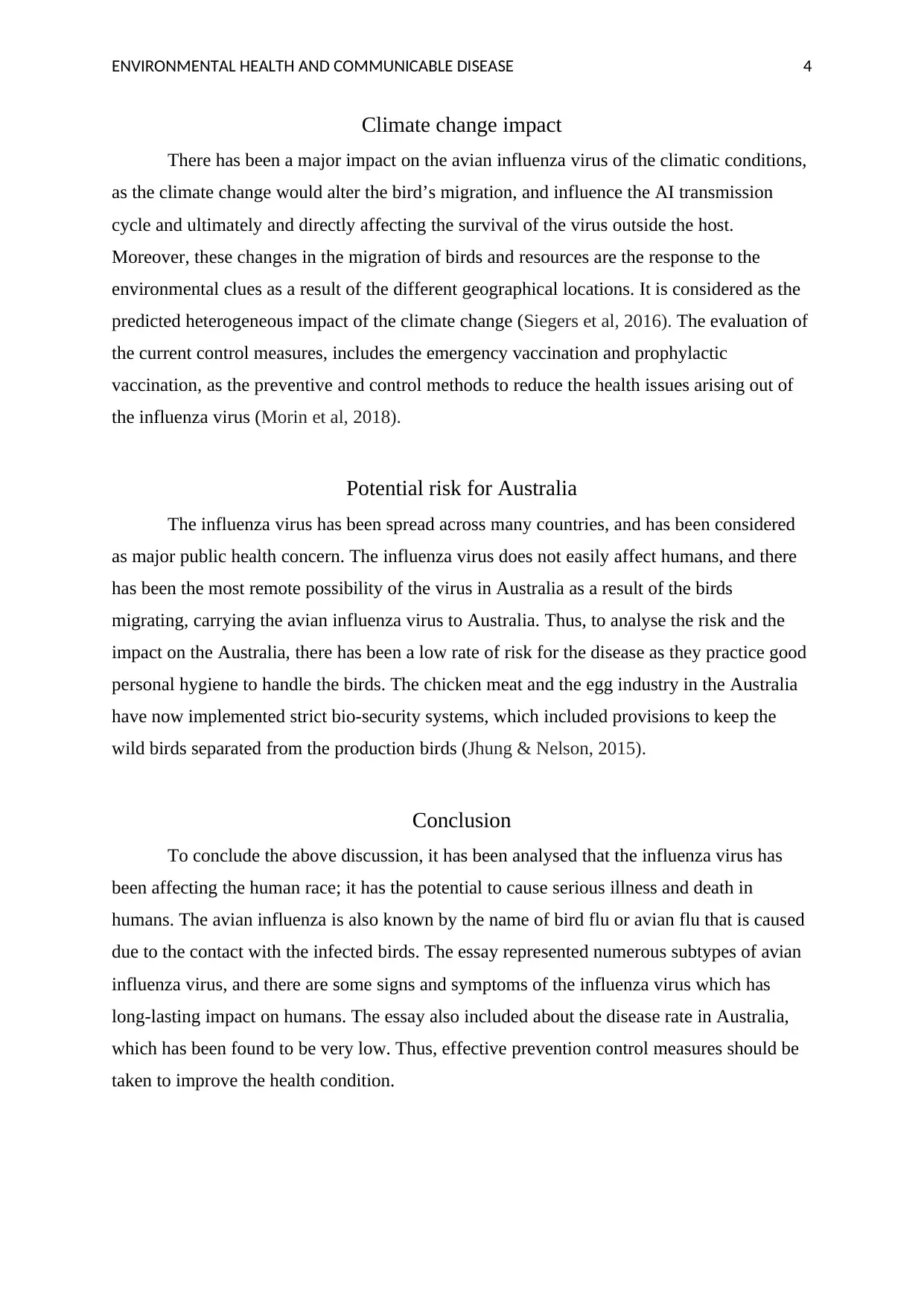
ENVIRONMENTAL HEALTH AND COMMUNICABLE DISEASE 4
Climate change impact
There has been a major impact on the avian influenza virus of the climatic conditions,
as the climate change would alter the bird’s migration, and influence the AI transmission
cycle and ultimately and directly affecting the survival of the virus outside the host.
Moreover, these changes in the migration of birds and resources are the response to the
environmental clues as a result of the different geographical locations. It is considered as the
predicted heterogeneous impact of the climate change (Siegers et al, 2016). The evaluation of
the current control measures, includes the emergency vaccination and prophylactic
vaccination, as the preventive and control methods to reduce the health issues arising out of
the influenza virus (Morin et al, 2018).
Potential risk for Australia
The influenza virus has been spread across many countries, and has been considered
as major public health concern. The influenza virus does not easily affect humans, and there
has been the most remote possibility of the virus in Australia as a result of the birds
migrating, carrying the avian influenza virus to Australia. Thus, to analyse the risk and the
impact on the Australia, there has been a low rate of risk for the disease as they practice good
personal hygiene to handle the birds. The chicken meat and the egg industry in the Australia
have now implemented strict bio-security systems, which included provisions to keep the
wild birds separated from the production birds (Jhung & Nelson, 2015).
Conclusion
To conclude the above discussion, it has been analysed that the influenza virus has
been affecting the human race; it has the potential to cause serious illness and death in
humans. The avian influenza is also known by the name of bird flu or avian flu that is caused
due to the contact with the infected birds. The essay represented numerous subtypes of avian
influenza virus, and there are some signs and symptoms of the influenza virus which has
long-lasting impact on humans. The essay also included about the disease rate in Australia,
which has been found to be very low. Thus, effective prevention control measures should be
taken to improve the health condition.
Climate change impact
There has been a major impact on the avian influenza virus of the climatic conditions,
as the climate change would alter the bird’s migration, and influence the AI transmission
cycle and ultimately and directly affecting the survival of the virus outside the host.
Moreover, these changes in the migration of birds and resources are the response to the
environmental clues as a result of the different geographical locations. It is considered as the
predicted heterogeneous impact of the climate change (Siegers et al, 2016). The evaluation of
the current control measures, includes the emergency vaccination and prophylactic
vaccination, as the preventive and control methods to reduce the health issues arising out of
the influenza virus (Morin et al, 2018).
Potential risk for Australia
The influenza virus has been spread across many countries, and has been considered
as major public health concern. The influenza virus does not easily affect humans, and there
has been the most remote possibility of the virus in Australia as a result of the birds
migrating, carrying the avian influenza virus to Australia. Thus, to analyse the risk and the
impact on the Australia, there has been a low rate of risk for the disease as they practice good
personal hygiene to handle the birds. The chicken meat and the egg industry in the Australia
have now implemented strict bio-security systems, which included provisions to keep the
wild birds separated from the production birds (Jhung & Nelson, 2015).
Conclusion
To conclude the above discussion, it has been analysed that the influenza virus has
been affecting the human race; it has the potential to cause serious illness and death in
humans. The avian influenza is also known by the name of bird flu or avian flu that is caused
due to the contact with the infected birds. The essay represented numerous subtypes of avian
influenza virus, and there are some signs and symptoms of the influenza virus which has
long-lasting impact on humans. The essay also included about the disease rate in Australia,
which has been found to be very low. Thus, effective prevention control measures should be
taken to improve the health condition.
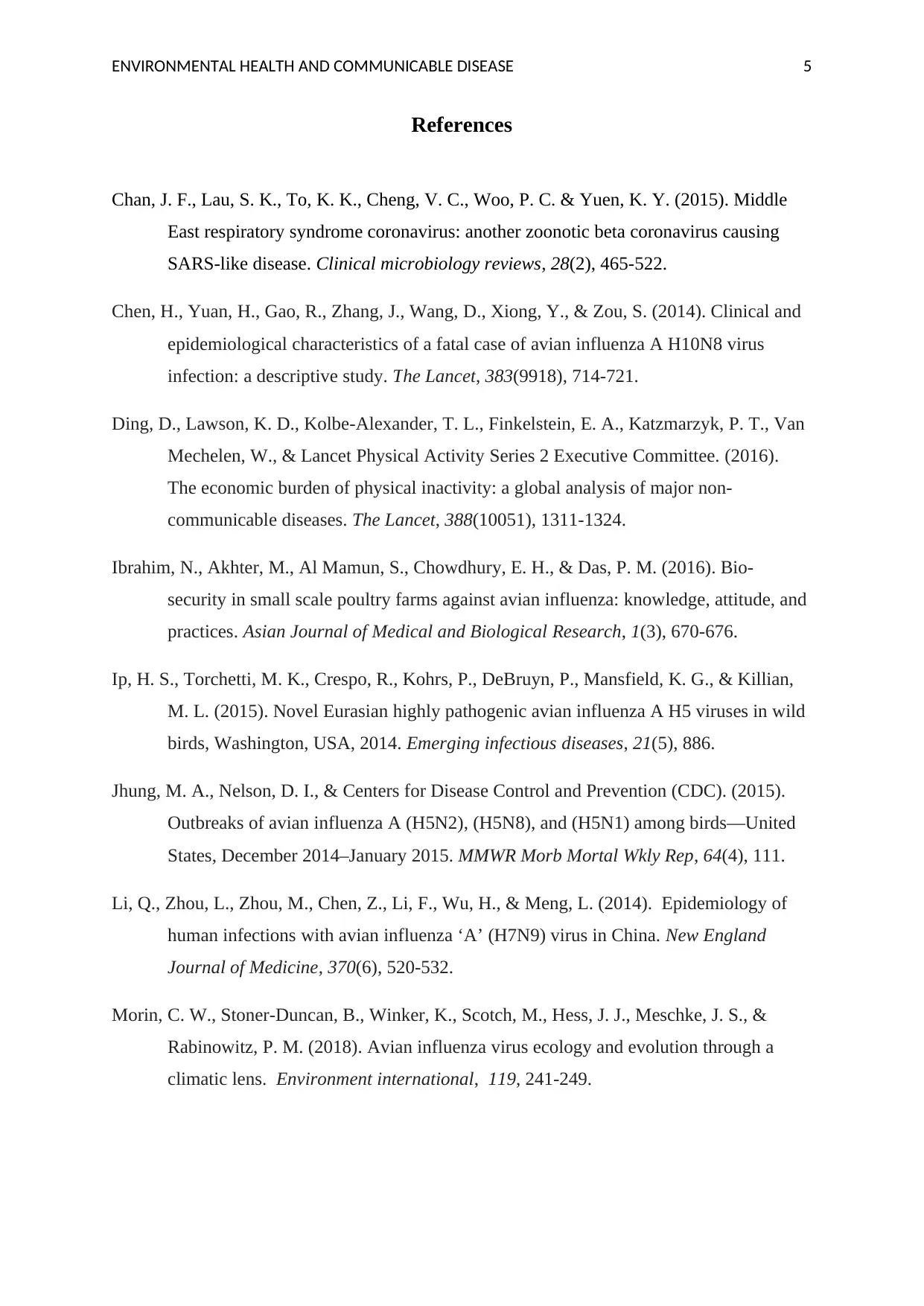
ENVIRONMENTAL HEALTH AND COMMUNICABLE DISEASE 5
References
Chan, J. F., Lau, S. K., To, K. K., Cheng, V. C., Woo, P. C. & Yuen, K. Y. (2015). Middle
East respiratory syndrome coronavirus: another zoonotic beta coronavirus causing
SARS-like disease. Clinical microbiology reviews, 28(2), 465-522.
Chen, H., Yuan, H., Gao, R., Zhang, J., Wang, D., Xiong, Y., & Zou, S. (2014). Clinical and
epidemiological characteristics of a fatal case of avian influenza A H10N8 virus
infection: a descriptive study. The Lancet, 383(9918), 714-721.
Ding, D., Lawson, K. D., Kolbe-Alexander, T. L., Finkelstein, E. A., Katzmarzyk, P. T., Van
Mechelen, W., & Lancet Physical Activity Series 2 Executive Committee. (2016).
The economic burden of physical inactivity: a global analysis of major non-
communicable diseases. The Lancet, 388(10051), 1311-1324.
Ibrahim, N., Akhter, M., Al Mamun, S., Chowdhury, E. H., & Das, P. M. (2016). Bio-
security in small scale poultry farms against avian influenza: knowledge, attitude, and
practices. Asian Journal of Medical and Biological Research, 1(3), 670-676.
Ip, H. S., Torchetti, M. K., Crespo, R., Kohrs, P., DeBruyn, P., Mansfield, K. G., & Killian,
M. L. (2015). Novel Eurasian highly pathogenic avian influenza A H5 viruses in wild
birds, Washington, USA, 2014. Emerging infectious diseases, 21(5), 886.
Jhung, M. A., Nelson, D. I., & Centers for Disease Control and Prevention (CDC). (2015).
Outbreaks of avian influenza A (H5N2), (H5N8), and (H5N1) among birds—United
States, December 2014–January 2015. MMWR Morb Mortal Wkly Rep, 64(4), 111.
Li, Q., Zhou, L., Zhou, M., Chen, Z., Li, F., Wu, H., & Meng, L. (2014). Epidemiology of
human infections with avian influenza ‘A’ (H7N9) virus in China. New England
Journal of Medicine, 370(6), 520-532.
Morin, C. W., Stoner-Duncan, B., Winker, K., Scotch, M., Hess, J. J., Meschke, J. S., &
Rabinowitz, P. M. (2018). Avian influenza virus ecology and evolution through a
climatic lens. Environment international, 119, 241-249.
References
Chan, J. F., Lau, S. K., To, K. K., Cheng, V. C., Woo, P. C. & Yuen, K. Y. (2015). Middle
East respiratory syndrome coronavirus: another zoonotic beta coronavirus causing
SARS-like disease. Clinical microbiology reviews, 28(2), 465-522.
Chen, H., Yuan, H., Gao, R., Zhang, J., Wang, D., Xiong, Y., & Zou, S. (2014). Clinical and
epidemiological characteristics of a fatal case of avian influenza A H10N8 virus
infection: a descriptive study. The Lancet, 383(9918), 714-721.
Ding, D., Lawson, K. D., Kolbe-Alexander, T. L., Finkelstein, E. A., Katzmarzyk, P. T., Van
Mechelen, W., & Lancet Physical Activity Series 2 Executive Committee. (2016).
The economic burden of physical inactivity: a global analysis of major non-
communicable diseases. The Lancet, 388(10051), 1311-1324.
Ibrahim, N., Akhter, M., Al Mamun, S., Chowdhury, E. H., & Das, P. M. (2016). Bio-
security in small scale poultry farms against avian influenza: knowledge, attitude, and
practices. Asian Journal of Medical and Biological Research, 1(3), 670-676.
Ip, H. S., Torchetti, M. K., Crespo, R., Kohrs, P., DeBruyn, P., Mansfield, K. G., & Killian,
M. L. (2015). Novel Eurasian highly pathogenic avian influenza A H5 viruses in wild
birds, Washington, USA, 2014. Emerging infectious diseases, 21(5), 886.
Jhung, M. A., Nelson, D. I., & Centers for Disease Control and Prevention (CDC). (2015).
Outbreaks of avian influenza A (H5N2), (H5N8), and (H5N1) among birds—United
States, December 2014–January 2015. MMWR Morb Mortal Wkly Rep, 64(4), 111.
Li, Q., Zhou, L., Zhou, M., Chen, Z., Li, F., Wu, H., & Meng, L. (2014). Epidemiology of
human infections with avian influenza ‘A’ (H7N9) virus in China. New England
Journal of Medicine, 370(6), 520-532.
Morin, C. W., Stoner-Duncan, B., Winker, K., Scotch, M., Hess, J. J., Meschke, J. S., &
Rabinowitz, P. M. (2018). Avian influenza virus ecology and evolution through a
climatic lens. Environment international, 119, 241-249.
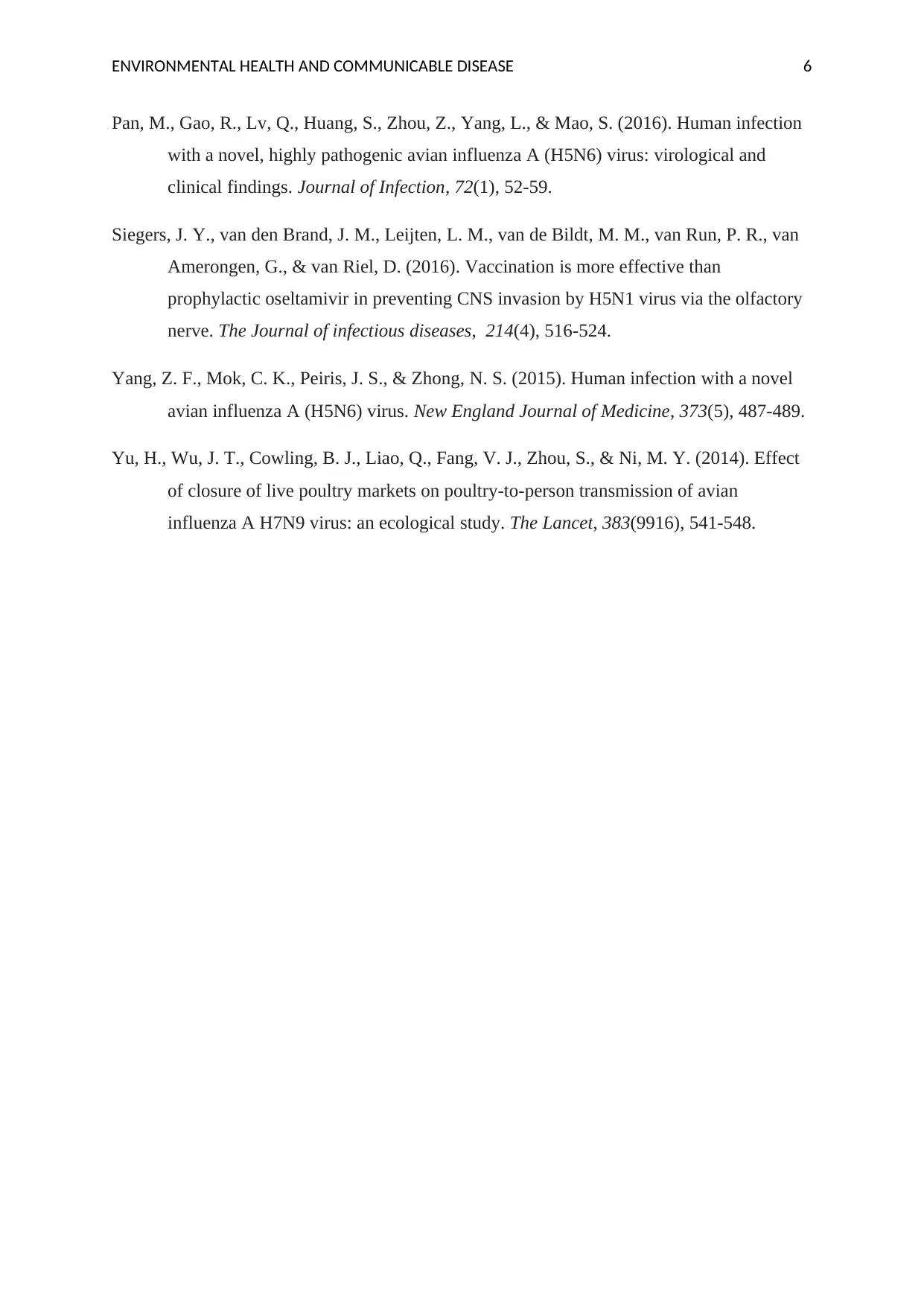
ENVIRONMENTAL HEALTH AND COMMUNICABLE DISEASE 6
Pan, M., Gao, R., Lv, Q., Huang, S., Zhou, Z., Yang, L., & Mao, S. (2016). Human infection
with a novel, highly pathogenic avian influenza A (H5N6) virus: virological and
clinical findings. Journal of Infection, 72(1), 52-59.
Siegers, J. Y., van den Brand, J. M., Leijten, L. M., van de Bildt, M. M., van Run, P. R., van
Amerongen, G., & van Riel, D. (2016). Vaccination is more effective than
prophylactic oseltamivir in preventing CNS invasion by H5N1 virus via the olfactory
nerve. The Journal of infectious diseases, 214(4), 516-524.
Yang, Z. F., Mok, C. K., Peiris, J. S., & Zhong, N. S. (2015). Human infection with a novel
avian influenza A (H5N6) virus. New England Journal of Medicine, 373(5), 487-489.
Yu, H., Wu, J. T., Cowling, B. J., Liao, Q., Fang, V. J., Zhou, S., & Ni, M. Y. (2014). Effect
of closure of live poultry markets on poultry-to-person transmission of avian
influenza A H7N9 virus: an ecological study. The Lancet, 383(9916), 541-548.
Pan, M., Gao, R., Lv, Q., Huang, S., Zhou, Z., Yang, L., & Mao, S. (2016). Human infection
with a novel, highly pathogenic avian influenza A (H5N6) virus: virological and
clinical findings. Journal of Infection, 72(1), 52-59.
Siegers, J. Y., van den Brand, J. M., Leijten, L. M., van de Bildt, M. M., van Run, P. R., van
Amerongen, G., & van Riel, D. (2016). Vaccination is more effective than
prophylactic oseltamivir in preventing CNS invasion by H5N1 virus via the olfactory
nerve. The Journal of infectious diseases, 214(4), 516-524.
Yang, Z. F., Mok, C. K., Peiris, J. S., & Zhong, N. S. (2015). Human infection with a novel
avian influenza A (H5N6) virus. New England Journal of Medicine, 373(5), 487-489.
Yu, H., Wu, J. T., Cowling, B. J., Liao, Q., Fang, V. J., Zhou, S., & Ni, M. Y. (2014). Effect
of closure of live poultry markets on poultry-to-person transmission of avian
influenza A H7N9 virus: an ecological study. The Lancet, 383(9916), 541-548.
1 out of 7
Related Documents
Your All-in-One AI-Powered Toolkit for Academic Success.
+13062052269
info@desklib.com
Available 24*7 on WhatsApp / Email
![[object Object]](/_next/static/media/star-bottom.7253800d.svg)
Unlock your academic potential
© 2024 | Zucol Services PVT LTD | All rights reserved.





